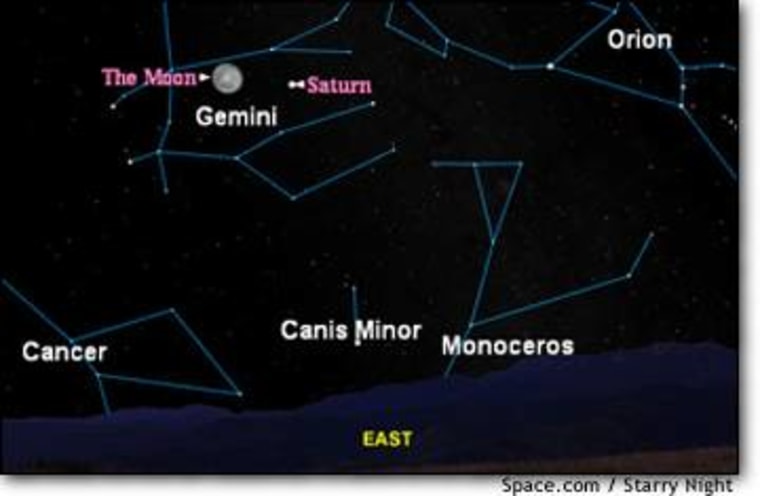On New Year’s Eve, the Lord of the Rings will be closer to Earth and brighter than at any time in three decades. All month long skywatchers can enjoy Saturn at its finest. A similar opportunity won’t come again for another 30 years. If in 2003 we had the Summer of Mars, this will be the Winter of Saturn.

ON DEC. 31, Saturn will be opposite the sun in relation to Earth. That means from our planet, Saturn will rise as the sun sets, reaching its highest point in the southern sky at midnight and setting as the sun rises. Astronomers call this opposition.
Saturn takes 29.42 years to orbit the sun. Its path is not quite circular, and it was just on July 26 that Saturn reached its closest point to the sun on that orbit, called perihelion. The near coincidence of perihelion and opposition dictates that on New Year’s Eve, Saturn will be closer to Earth than at any time since December 1973.
THOSE GLORIOUS RINGS
The ringed planet will be 748.3 million miles (1.2 billion kilometers) from Earth. It will not come closer until January 2034. Contrast this year’s event to another opposition, in June 2018, when Saturn will get no closer than 841 million miles, or almost 100 million miles farther away.
There’s a bonus. Saturn’s rings are not always well-tilted for viewing. Sometimes they are edge on, as seen from Earth, and unimpressive.
Right now, the rings are still dramatically tipped — more than 25 degrees to our line of sight. This allows the planet to be seen in all its glory, and it also accentuates Saturn’s brightness.
By the end of December, Saturn will be shining as bright as it can ever get, at magnitude -0.5. Among the stars, only Sirius and Canopus are brighter.

FINDING SATURN
With a simple sky map, Saturn is easy to find right now.
It is currently in the constellation of Gemini the Twins. Were we to use the popular tracing conceived by H.A. Rey, of “two matchstick men holding hands,” Saturn is found between the legs of the twins.
Early on Wednesday evening, Dec. 10, Saturn will be the very bright yellowish-white “star” hovering to the lower right of a waning gibbous moon as they rise out of the east-northeast part of the sky.
Saturn is the telescopic showpiece of the night sky, thanks to its great ring system in all of its icy, glimmering elegance. In small telescopes, the rings surprise even veteran observers with their chilling beauty. Certainly they will delight anyone this winter who might receive a telescope as a holiday gift.
Any telescope magnifying more than 30 times will show them. Even most inexpensive department store telescopes should do the job (though if you’re thinking about buying a telescope, you’ll want to learn more and become a discerning buyer — there’s a lot of junk on the market.)
THE CHILDREN OF SATURN
Galileo Galilei (1564-1642) was the first to view the rings, in 1610. What he saw through his crude telescope left him completely baffled, as Saturn appeared to him not to have rings but rather two smaller bodies flanking it, one on either side. He couldn’t make them out clearly and thought that Saturn was a triple body, two small orbs attached to a large one.
Later, when the rings turned edgewise to Earth and the two companions disappeared, Galileo invoked an ancient myth when he wrote, “Has Saturn swallowed his children?” Galileo lamented that his mind was too weak to comprehend this strange phenomenon.
Actually, it was his telescope that was too weak; a better one would have revealed Saturn’s companions as rings. It was not until a young Dutch mathematician, Christian Huygens (1629-1695), utilized a much better telescope that the rings were first seen for what they really were, on March 25, 1655.
In mythology, Saturn closely resembled the Greek god Cronus, but he’s more usually recognized as the Roman god of agriculture.
The name is related to both the noun “satus” (seed corn) and the verb “serere” (to sow). But why would the planet Saturn be linked to agriculture? Perhaps a clue can be found from the ancient Assyrians, who referred to Saturn as “lubadsagush,” which meant “oldest of the old sheep.”
Possibly this name was applied because Saturn seems to move so very slowly among the stars, compared with nearer planets that shift their seasonal positions in the sky more quickly. It may have also reminded skywatchers of the slow gait of plowing oxen or cattle.
Closer views of Saturn are slated for next year. NASA’s Cassini spacecraft will arrive at the ringed planet and is expected to produce the best images and data ever collected of the sixth planet from the sun.
Joe Rao serves as an instructor and guest lecturer at New York’s Hayden Planetarium. He writes about astronomy for The New York Times and other publications, and he is also an on-camera meteorologist for News 12 Westchester, New York.
© 2003 Space.com. All rights reserved.